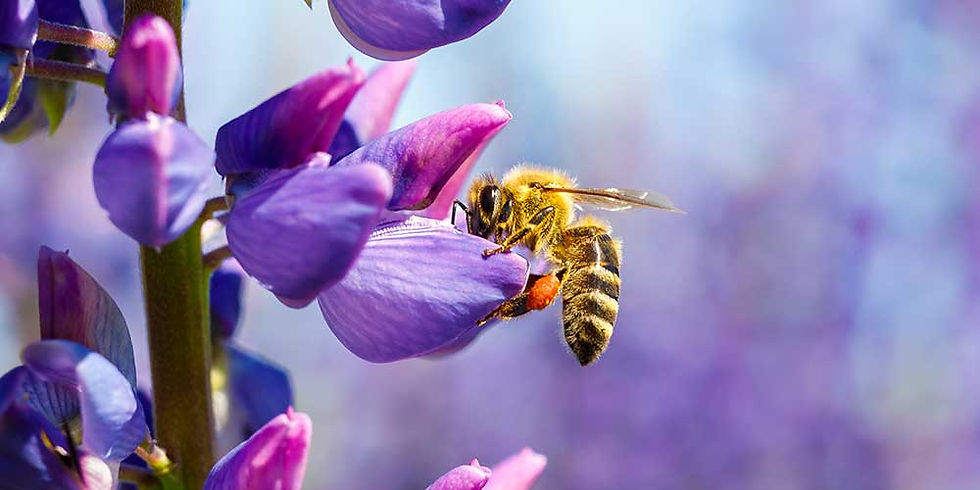How Honey is Made: 5 Steps Behind the Sweet Stuff
- Chelsea Vincent
- Mar 12, 2019
- 3 min read
Updated: Mar 15, 2021
WHAT HAPPENS BEFORE HONEY GETS TO THE JAR

As a kid, most of us knew that honey comes from bees. Whether we watched Winnie the Pooh or saw bees buzzing around flowers in the spring, we came to understand that the magic of honey was indebted to these tiny, flying creatures.
But how is honey made, exactly? Most of us know it involves beekeepers – in what look like HAZMAT suits – and we love to slather honey on or biscuits or sweeten our tea with it, but the process behind it is actually quite interesting.
PART ONE: FLOWERS PRODUCE NECTAR
Let’s start with a little plant science 101. We all know that plants need sunlight to grow, and they actually use that energy derived from sunlight to create sugar. When leaves gather light from the sun, water and carbon dioxide are combined to make sugar, during the process we call photosynthesis (you probably remember that word from your school days).
"The chemical compositions of nectar varies slightly from one plant to another, which is why you may notice different types of honey can have different tastes."
This sugar then moves to other parts of the plant, where it is used to fuel the plant (like glycogen, which comes from sugar, fuels human muscles). Specialized cells release sugar as a secretion known as nectar, which mammals, bugs, and birds all seek out.
(Fun fact here: the chemical compositions of nectar varies slightly from one plant to another, which is why you may notice different types of honey can have different tastes. For instance, clover honey and orange blossom honey have distinctly different flavor profiles.)
PART TWO: BEES COLLECT NECTAR
Alright. So flowering plants have now produced nectar, which delights bees (and anything or anyone who likes sweetness). At this point, forager bees swing by and drink the nectar with their long tongue, then store the honey in a special honey stomach, known as a crop.
The crop is like a fanny pack for a bee, as no digestion takes place here – it’s simply for storage. During the time the honey is stashed away in the crop, it mixes with enzymes from the forager bee, which enable it to be stored long-term.
PART THREE: HONEY IS DEPOSITED IN THE HIVE
Now things start to get really exciting, as the bees bring the bounty home. The forager bee brings the nectar back and regurgitates it to the crop of another bee, called a processor bee. (Yep – there’s a lot of sharing going on.)
The processor bee then whisks the stored nectar away to the honeycomb and regurgitates it into a wax cell (the shapes you see in the honeycomb). It’s a bit like depositing money in the bank. At this point, the nectar starts to earn interest, or, in other words, ripen.
Thanks to an enzyme supplied by the processor bee, when the honey ripens, it changes from sucrose and water to fructose and water. Basically, the honey goes from being the same compound as table sugar to the sugar found in fruit.
As the honey ripening progresses, bees fan their wings, and excess water evaporates, a bit like a shop vac. This process helps to dry out the nectar so that it achieves the texture we eventually see in honey jars.
PART FOUR: HONEYCOMB IS SEALED
After the shop vac action is completed, the honeycomb cell is sealed off with a wax seal from the bee’s abdomen secretions. This airtight seal keeps the honey from having fungus or bacteria grow with it.
As long as the honey steers clear of air and water, it can be stored long-term. Thus, when the winter comes around and there aren’t flowers in bloom the bees still have an accessible food source. In this way, it’s just like when people can or jar foods for the winter. The seal must be tight enough to guarantee an extended shelf life, and as long as the jar isn’t open, the food can be enjoyed throughout the winter.
PART FIVE: HONEY IS EXTRACTED AND PROCESSED
The final phase in honey’s journey, as far as a final human destination, includes the beekeeper. The beekeeper gathers the frames of honeycomb from boxes made just for the bees.
Finally, the wax caps are scraped off of the honeycomb cells, so that the honey can be extracted from the structure. Honey is then strained and added to bottles, labels are added, and the products are shipped far and wide for people to enjoy eating or for beauty purposes.

Knowing the fascinating story behind how honey is made makes it that much sweeter, and the next time you enjoy the rich, golden taste, you may find yourself thinking back to just how much love and time went into making such a lovely and healing treat.
Find more delicious and nutritious recipes, beauty tips, crafts, and fun honey facts with



Comments